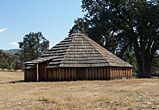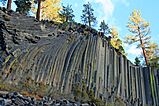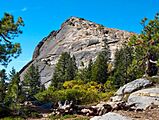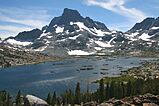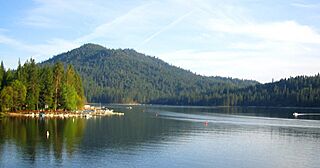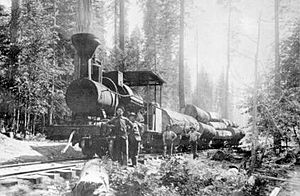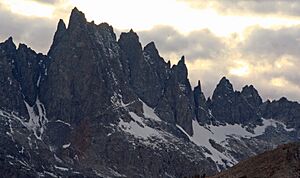Madera County, California facts for kids
Quick facts for kids
Madera County
|
||
|---|---|---|
| County of Madera | ||
|
Images, from top down, left to right: Wassama Round House State Historic Park, Devils Postpile National Monument, Fresno Dome, Banner Peak above Thousand Island Lake, Bass Lake
|
||
|
||
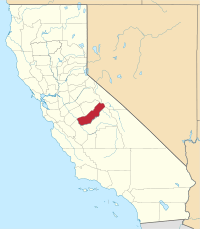
Location in the state of California
|
||
| Country | United States | |
| State | California | |
| Regions | San Joaquin Valley, Sierra Nevada | |
| Metropolitan area | Metropolitan Fresno | |
| Incorporated | 1893 | |
| Named for | Spanish word meaning "wood" | |
| County seat | Madera | |
| Largest city | Madera | |
| Government | ||
| • Type | Council–CAO | |
| • Body | Board of Supervisors | |
| Area | ||
| • Total | 2,153 sq mi (5,580 km2) | |
| • Land | 2,137 sq mi (5,530 km2) | |
| • Water | 16 sq mi (40 km2) | |
| Highest elevation | 13,143 ft (4,006 m) | |
| Population
(2020)
|
||
| • Total | 156,255 | |
| • Density | 72.575/sq mi (28.022/km2) | |
| GDP | ||
| • Total | $7.738 billion (2022) | |
| Time zone | UTC−8 (Pacific Time Zone) | |
| • Summer (DST) | UTC−7 (Pacific Daylight Time) | |
| FIPS code | 06-039 | |
| GNIS feature ID | 277284 | |
| Congressional districts | 5th, 13th | |
Madera County is a county in the middle of California. It has many different types of land, from the flat San Joaquin Valley to the tall Sierra Nevada mountains. The city of Madera is its county seat, which is like its main city. The county was created in 1893 from a part of Fresno County. In 2020, about 156,255 people lived there.
The name "Madera" means "wood" in Spanish. This name shows the county's past connection to the lumber industry. A part of Yosemite National Park is inside Madera County, which helps bring in tourists. The county is also a big farming area, known for growing lots of almonds, grapes, and pistachios. Madera County has a very diverse population. Many people have Native American roots, and many others have moved there from different countries.
Contents
Etymology
"Madera" is the Spanish word for wood. The county got its name from the town of Madera. This town was named in 1876 when the California Lumber Company built a special log flume. This flume was used to float cut wood down to the Central Pacific Railroad in the town.
History of Madera County
Madera County was officially formed in 1893. Before that, it was part of Fresno County. People in the area voted to separate from Fresno County. The vote happened on May 16, 1893, and most people wanted Madera County to be its own county.
The Madera County Sheriff's Department had the first woman in California to die while working as a police officer. Her name was Lucille Helm (1914–1959). She worked for 15 years helping with female prisoners.
Early Human History
Native People
The land that is now Madera County was first home to several Native American tribes. These included the Mono, Chukchansi, and Miwok tribes. The Mono people lived near the San Joaquin River, in areas like North Fork and Crane Valley. The Chukchansi tribe lived in places like Oakhurst, Coarsegold, and Ahwahnee. The Miwok lived near Ahwahnee, Wawona, and the Yosemite Valley.
After the California Gold Rush, many Native American communities were forced to move from their homes. This was made worse by the Mariposa War and laws that made things difficult for them. But many communities kept their traditional ways of life. Later, in 1924, Native Americans were given full citizenship through the Indian Citizenship Act.
Immigration and Migration
People Moving to Madera
Since this area was part of Mexico until 1848, it has always had many people of Mexican descent. After the California Gold Rush, people from all over the United States and other countries came to live here.
Chinese laborers helped build the Madera Flume and worked in the lumber yards. However, their numbers went down after laws like the Chinese Exclusion Act made it harder for them to come to the U.S. Then, Mexican immigrants started doing the jobs that Chinese workers used to do.
20th Century Changes
In the 1930s, many families from the Dust Bowl areas, like Oklahoma and Arkansas, moved to Madera County.
In the middle of the 1900s, the Bracero Program brought workers from Mexico to help with farming. This was important during World War II and the Korean War when there weren't enough farmworkers. Even after this program ended in 1964, people continued to move here for work. By the 1990s, many of these workers were Mixtecs from Oaxaca, Mexico.
Geography of Madera County
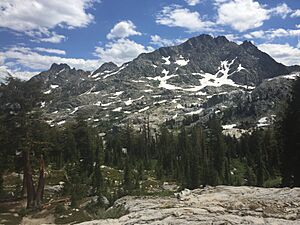
Madera County has many different types of land. You can find the rich farmlands of the San Joaquin Valley, grassy areas, oak forests, and the rocky Sierra Nevada mountains. A large part of Yosemite National Park is in the county, known for its wild nature and high mountain areas. Madera County also has important rivers like the San Joaquin River, and many lakes and reservoirs. These are important for farming, nature, and fun activities.
The county has different climates, from dry in the valley to very cold in the high Sierra Nevada. This creates many different natural environments.
The U.S. Census Bureau says the county covers about 2,153 square miles. Most of this is land, and a small part is water.
Madera County is also part of the Madera AVA wine region, where grapes are grown for wine.
National Protected Areas
- Devils Postpile National Monument
- Inyo National Forest (part)
- Sierra National Forest (part)
- Yosemite National Park (part)
Population and People
| Historical population | |||
|---|---|---|---|
| Census | Pop. | %± | |
| 1900 | 6,364 | — | |
| 1910 | 8,368 | 31.5% | |
| 1920 | 12,203 | 45.8% | |
| 1930 | 17,164 | 40.7% | |
| 1940 | 23,314 | 35.8% | |
| 1950 | 36,964 | 58.5% | |
| 1960 | 40,468 | 9.5% | |
| 1970 | 41,519 | 2.6% | |
| 1980 | 63,116 | 52.0% | |
| 1990 | 88,090 | 39.6% | |
| 2000 | 123,109 | 39.8% | |
| 2010 | 150,865 | 22.5% | |
| 2020 | 156,255 | 3.6% | |
| 2023 (est.) | 162,858 | 7.9% | |
| U.S. Decennial Census 1790–1960 1900–1990 1990–2000 2010 2020 |
|||
Madera County has a growing population. In 2020, there were 156,255 people living there. The county has a diverse population. Many residents are of Hispanic or Latino background. Also, a good number of people living in Madera County were born in other countries. This mix of cultures means that nearly half of the people speak a language other than English at home.
The county has more young people than the national average. About 27% of the population is under 18 years old. When it comes to homes, Madera County has more affordable rent compared to the rest of California. Also, more people own their homes here than in California overall.
Economy
Past Industries

Madera County's economy has changed a lot over time. In the beginning, it depended heavily on getting natural resources like minerals and wood. Later, farming and related businesses became the most important parts of the economy.
Gold Mining
Madera County became famous for gold mining during the California Gold Rush. Most of the county's gold mines were found where the Sierra Nevada mountains meet older rocks. These mines stretched from Grub Gulch to Hildreth.
Grub Gulch was a busy gold rush town known for its easy-to-find gold. It started as a small camp but grew into a lively community in the late 1880s. This was thanks to successful placer mining in nearby streams. At its busiest, the town had five saloons, a general store, a post office, and a boarding house. Almost $1 million of the $1.35 million worth of gold found in Madera County came from Grub Gulch. By the 1950s, gold mining had mostly stopped.
Tungsten Mining
In the middle of the 1900s, the high Sierra regions of Madera County became important for their large amounts of tungsten. This led to a lot of mining near Mammoth Lakes, Central Camp, and Fish Camp. For example, the Strawberry Tungsten Mine was worth $1 million in 1955.
However, tungsten mining in the Sierra Nevada faced problems. These included harsh winters and strong competition from cheaper tungsten from China. Because of these issues, tungsten mining in Madera County and the rest of the Sierra Nevada has now completely stopped.
Lumber Industry
After gold was discovered, there was a huge need for lumber. Wood was needed to build sluice boxes for mining and to build new towns. The first sawmill in the county was built in 1852. It was located north of Oakhurst. This mill provided wood to miners and settlers in the Coarsegold and Fresno Flats areas.
In 1872, the California Lumber Company started a big lumber business. They built a record-breaking log flume that was 65 miles long. This flume floated cut lumber to Madera to be sold. Even though the company had money problems at first, it later did very well for the next 40 years.
During the Great Depression, the lumber industry in Madera County stopped working. It started up again in 1941 when a new sawmill was built. This mill used logging trucks and modern tools to reach deeper into the Sierra National Forest. However, in the early 1990s, new government rules reduced how much wood could be cut. This led to the end of Madera County's logging era in February 1994.
Modern Economy
Jobs in Madera County
Madera County's jobs include traditional industries like farming and making goods. It also has many jobs in hotels, restaurants, and other services. Here are the main job areas in Madera County:
| Sector | Employment Share |
|---|---|
| Government | 12.71% |
| Farm | 12.08% |
| Health & Education | 11.08% |
| Wholesale & Retail Trade | 5.45% |
| Leisure | 4.26% |
| Professional Services | 3.63% |
| Manufacturing | 3.31% |
| Construction | 2.14% |
| Transportation and Utilities | 1.44% |
| Financial Activities | 0.71% |
| Information | 0.30% |
Looking ahead, jobs in Government, Health and Education, and Professional Services are expected to grow the fastest.
Farming in Madera County
Madera County focuses a lot on growing crops that stay in the ground for many years. Almonds are the top crop, followed by grapes and pistachios. Raising cattle and providing services for almond pollination are also very important. In 2022, all the crops grown in Madera County were worth $1.9 billion. The county is known for its farming. It ranks #1 in California for growing figs. It is also #4 for almonds, nuts, grapes (especially raisins), and pistachios.
| Commodity | 2022 Rank | 2022 Dollar Value | 2021 Rank |
|---|---|---|---|
| Almonds, Nuts & Hulls | 1 | $570,739,000 | 1 |
| Milk | 2 | $454,727,000 | 2 |
| Grapes | 3 | $233,893,000 | 3 |
| Pistachios | 4 | $227,873,000 | 4 |
| Pollination | 5 | $66,880,000 | 5 |
| Cattle & Calves | 6 | $62,317,000 | 6 |
| Mandarins & Tangerines | 7 | $45,036,000 | 7 |
| Corn Silage | 8 | $37,293,000 | 9 |
| Replacement Heifers | 9 | $34,255,000 | 8 |
| Alfalfa, Hay & Silage* | 10 | $26,845,000 | ** |
In the 1990s, many Mixtec farmworkers from Mexico came to work in the county's farms.
Education
Madera County is mostly served by the State Center Community College District. This district is centered around Fresno City College in Fresno. Other college districts also cover parts of Madera County.
Here are some of the school districts in the county:
- Chawanakee Unified School District
- Firebaugh-Las Deltas Unified School District
- Golden Valley Unified School District
- Madera Unified School District
- Yosemite Unified School District
- Chowchilla Union High School District
- Alview-Dairyland Union Elementary School District
- Bass Lake Joint Union Elementary School District
- Chowchilla Elementary School District
- Raymond-Knowles Union Elementary School District
Fun Places to Visit
Madera County has many cool places to visit, especially if you love nature and outdoor activities!
- Bass Lake
- Chukchansi Gold Resort & Casino
- Corlieu Falls
- Fresno Dome
- Hensley Lake
- Mammoth Pool Reservoir
- Nelder Grove
- Mount Ritter
- Sierra Vista Scenic Byway
- Yosemite National Park
Transportation
Main Roads
 State Route 41
State Route 41 State Route 49
State Route 49 State Route 99
State Route 99 State Route 145
State Route 145 State Route 152
State Route 152 State Route 233
State Route 233
Areas Without Roads
Some eastern parts of Madera County, like Devil's Postpile National Monument and part of Minaret Summit, cannot be reached by road from the rest of the county. To get there, you usually have to drive through Mono County on Minaret Summit Road, which becomes State Route 203 and leads to Mammoth Lakes.
There was once a plan to build a highway or tunnel to connect the eastern Sierra Nevada to the San Joaquin Valley. However, former California Governor and later President Ronald Reagan went on a trip to this area. After seeing its beauty, he worked with groups that wanted to protect nature. His efforts helped make this area a protected wilderness in 1984, stopping the road from being built.
Public Transportation
- Madera County Connection offers bus services between the cities of Madera and Chowchilla. It also has routes to eastern Madera County. You can connect to Fresno at Valley Children's Hospital.
- The cities of Madera and Chowchilla have their own local bus services called Madera Metro and Chowchilla Area Transit.
- Greyhound buses and Amtrak trains stop in Madera.
Airports
- Madera Municipal Airport and Chowchilla Airport are smaller airports used for general aviation.
Communities

Madera County has two main cities and many smaller communities.
Cities
- Chowchilla
- Madera (the county seat)
Other Communities
- Ahwahnee
- Bass Lake
- Bonadelle Ranchos
- Coarsegold
- Fairmead
- La Vina
- Madera Acres
- Madera Ranchos
- Nipinnawasee
- North Fork
- Oakhurst
- Parksdale
- Parkwood
- Rolling Hills
- Yosemite Lakes
- Knowles
- O'Neals
- Raymond
- Ripperdan
- Sugar Pine
- Sumner Hill
Images for kids
See also
 In Spanish: Condado de Madera para niños
In Spanish: Condado de Madera para niños


